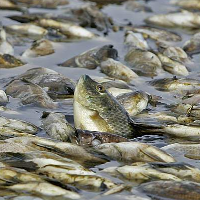Odor Alert at Salton Sea Is Reminder that Ecological Disaster Looms
 Dead and dying tilapia in the Salton Sea (photo: Jay Calderon, The Desert Sun)
Dead and dying tilapia in the Salton Sea (photo: Jay Calderon, The Desert Sun)
The Salton Sea sent out a pungent reminder for miles around this week that California’s largest inland lake is dying and will exact a heavy environmental toll if allowed to dry up.
The South Coast Air Quality Management District (AQMD) issued an odor advisory for the Coachella Valley on Tuesday that most anyone inhaling there probably suspected was coming. The agency warned that due to elevated concentrations of hydrogen sulfide (pdf) from the rapidly evaporating sea, the area would smell like rotten eggs for a while.
The state standard for hydrogen sulfide outdoors is 30 parts per billion but reached 106 Monday night. “At that level individuals may experience symptoms such as headaches and nausea,” the AQMD warned. The federal Centers for Disease Control and Prevention (CDC) says:
“Exposure to high levels of hydrogen sulfide results in unconsciousness followed by apparent recovery, colloquially referred to as knockdown. Some individuals report permanent or persistent neurological effects after the apparent recovery.”
The 350-square-mile lake was created in 1905 when a diversion of the Colorado River went awry and flooded an ancient lake bed. The Salton Sea became a popular resort area in the 1930s, was stocked with sport fish and hosted a celebrity crowd for years until it became apparent in the ‘50s that the water’s salinity was increasing and the lake was shrinking.
Discussions began about how to save the Salton Sea, but little came of them. State legislation in 2004 directed the Natural Resources Agency and the departments of Water Resources and Fish and Game to come up with a plan save the lake, which had developed into a thriving ecosystem and become a critical habitat for migrating birds. A 25-year, $8.9 billion restoration project was proposed in 2007.
That didn’t happen.
Two weeks ago Pacific Institute released a report (pdf) that said failure to save the sea could worsen air quality, destroy valuable ecological habitat, diminish recreational revenue and devalue property―all at a cost to the state of up to $70 billion over 30 years.
Although the rotten smell of the decaying lake is nothing to be sniffed at, the report points out that a larger danger of a dry sea bed is from blowing dust in a region with 650,000 people.
The projected high cost of the 2007 restoration plan, just as the economy was beginning to tank from the global financial crisis, was further complicated a few years later by drought imperatives that made the shifting of water supplies to the desert location problematic. But, according to the Pacific Institute researchers, decision-makers figured that delay wouldn’t make things much worse.
That is apparently not the case.
The report projects that over the next 15 years, the amount of water flowing into the sea will decrease by about 40%. The surface will drop 20 feet and its volume will shrink more than 60%. Salinity will triple and 100 dusty square miles of lake bottom will be exposed, reducing the air quality throughout the region. “The lake’s habitat value for hundreds of species of resident and migratory birds will rapidly decline.”
By 2045, 150 square miles of lake bottom will be exposed, adding as much as 100 tons of fine dust to the air daily. The lake will be filled with algae, bacteria and viruses, “providing no value to birds or people.”
Not much of a fuss was made about the Salton Sea between 2007, when lawmakers brushed off the call for a restoration project, and 2012. But that year, a large storm carried a huge release of hydrogen sulfide 150 miles across Southern California and suddenly the problem was under a lot more people’s noses.
Now, as then, that smell got people talking. It remains to be seen if the result will be any different.
–Ken Broder
To Learn More:
Salton Sea Odors Prompt Advisory by Air Agency (by Ian James, The Desert Sun)
Salton Sea Inaction Would Cost Billions, Report Finds (by Janet Zimmerman, Riverside Press-Enterprise)
Salton Sea Could Benefit from CA Water Bond (by Chris Nichols, U-T San Diego)
A Persuasive Case for Saving the Salton Sea, California's Biggest Lake (by Patt Morrison, Los Angeles Times)
Something Stinks Besides the Rotting Fish at the Salton Sea (by Ken Broder, AllGov California)
Hazard’s Toll: The Costs of Inaction at the Salton Sea (Pacific Institute) (pdf)
- Top Stories
- Controversies
- Where is the Money Going?
- California and the Nation
- Appointments and Resignations
- Unusual News
- Latest News
- California Forbids U.S. Immigration Agents from Pretending to be Police
- California Lawmakers Urged to Strip “Self-Dealing” Tax Board of Its Duties
- Big Oil’s Grip on California
- Santa Cruz Police See Homeland Security Betrayal in Use of Gang Roundup as Cover for Immigration Raid
- Oil Companies Face Deadline to Stop Polluting California Groundwater





